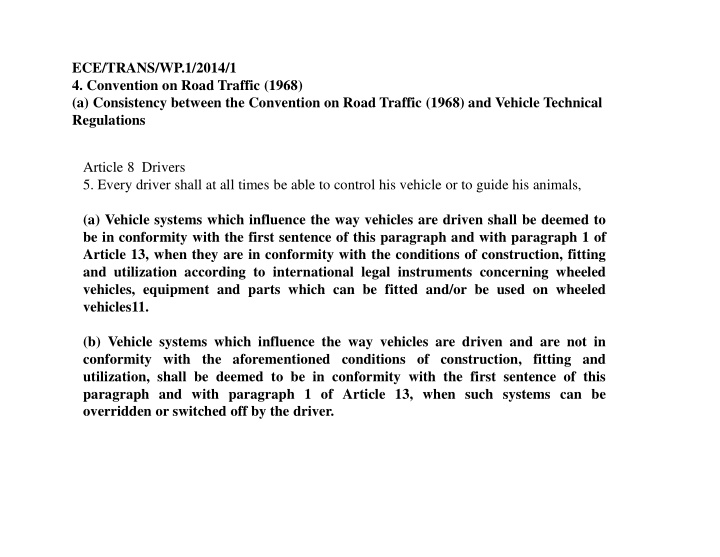



ECE/TRANS/WP.1/2014/1 4. Convention on Road Traffic (1968) (a) Consistency between the Convention on Road Traffic (1968) and Vehicle Technical Regulations Article 8 Drivers 5. Every driver shall at all times be able to control his vehicle or to guide his animals, (a) Vehicle systems which influence the way vehicles are driven shall be deemed to be in conformity with the first sentence of this paragraph and with paragraph 1 of Article 13, when they are in conformity with the conditions of construction, fitting and utilization according to international legal instruments concerning wheeled vehicles, equipment and parts which can be fitted and/or be used on wheeled vehicles11. (b) Vehicle systems which influence the way vehicles are driven and are not in conformity with the aforementioned conditions of construction, fitting and utilization, shall be deemed to be in conformity with the first sentence of this paragraph and with paragraph 1 of Article 13, when such systems can be overridden or switched off by the driver.
ECE/TRANS/WP.1/2014/1 4. Convention on Road Traffic (1968) (a) Consistency between the Convention on Road Traffic (1968) and Vehicle Technical Regulations Article 8 Drivers 5. Every driver shall at all times be able to control his vehicle or to guide his animals, (a) Vehicle systems which influence the way vehicles are driven shall be deemed to be in conformity with the first sentence of this paragraph and with paragraph 1 of Article 13, when they are in conformity with the conditions of construction, fitting and utilization according to international legal instruments concerning wheeled vehicles, equipment and parts which can be fitted and/or be used on wheeled vehicles. The UN Regulations annexed to the "Agreement concerning the adoption of uniform technical prescriptions for wheeled vehicles, equipment and parts which can be fitted and/or be used on wheeled vehicles and the conditions for reciprocal recognition of approvals granted on the basis of these prescriptions" done at Geneva on 20 March 1958. The UN Global Technical Regulations developed in the framework of the "Agreement concerning the establishing of global technical regulations for wheeled vehicles, equipment and parts which can be fitted and/or be used on wheeled vehicles" done at Geneva on 25 June 1998.
ECE/TRANS/WP.1/2014/1 4. Convention on Road Traffic (1968) (a) Consistency between the Convention on Road Traffic (1968) and Vehicle Technical Regulations Article 8 Drivers 5. Every driver shall at all times be able to control his vehicle or to guide his animals, (a) Vehicle systems which influence the way vehicles are driven shall be deemed to be in conformity with the first sentence of this paragraph and with paragraph 1 of Article 13, when they are in conformity with the conditions of construction, fitting and utilization according to international legal instruments concerning wheeled vehicles, equipment and parts which can be fitted and/or be used on wheeled vehicles. Background: A driver might not be able to show appropriate actions or reactions in a potentially dangerous driving situation, but the system can perform this action properly. To ensure highest effectiveness, these systems shall not necessarily be overridable / able to be switched off.
ECE/TRANS/WP.1/2014/1 4. Convention on Road Traffic (1968) (a) Consistency between the Convention on Road Traffic (1968) and Vehicle Technical Regulations Article 8 Drivers 5. Every driver shall at all times be able to control his vehicle or to guide his animals, (a) Vehicle systems which influence the way vehicles are driven shall be deemed to be in conformity with the first sentence of this paragraph and with paragraph 1 of Article 13, when they are in conformity with the conditions of construction, fitting and utilization according to international legal instruments concerning wheeled vehicles, equipment and parts which can be fitted and/or be used on wheeled vehicles. Example: UNECE Regulation 13-H "Electronic Stability Control System (ESC System) 2.25.1 A system that improves computer controlled vehicle directional stability controlling individually the braking torques of each wheel basing on the evaluation of the actual vehicle behaviour in comparison with a determination of the vehicle behaviour demanded by the driver.
ECE/TRANS/WP.1/2014/1 4. Convention on Road Traffic (1968) (a) Consistency between the Convention on Road Traffic (1968) and Vehicle Technical Regulations Article 8 Drivers 5. Every driver shall at all times be able to control his vehicle or to guide his animals, (b) Vehicle systems which influence the way vehicles are driven and are not in conformity with the aforementioned conditions of construction, fitting and utilization, shall be deemed to be in conformity with the first sentence of this paragraph and with paragraph 1 of Article 13, when such systems can be overridden or switched off by the driver. Background: Overrideability as well as the possibility for the driver to switch systems off ensure that the driver’s will is put forth. The driver is kept in a superior role. Example: Adaptive Cruise Control. The system controls the forward guidance of the vehicle and makes the vehicle follow a forward vehicle at a certain distance. The driver controls only the other task (the lateral guidance), but is able to undertake the forward guidance at any time by braking or accelerating.
Recommend
More recommend